20 Breeds of Ducks in Indiana (With Pictures)
Last Updated on
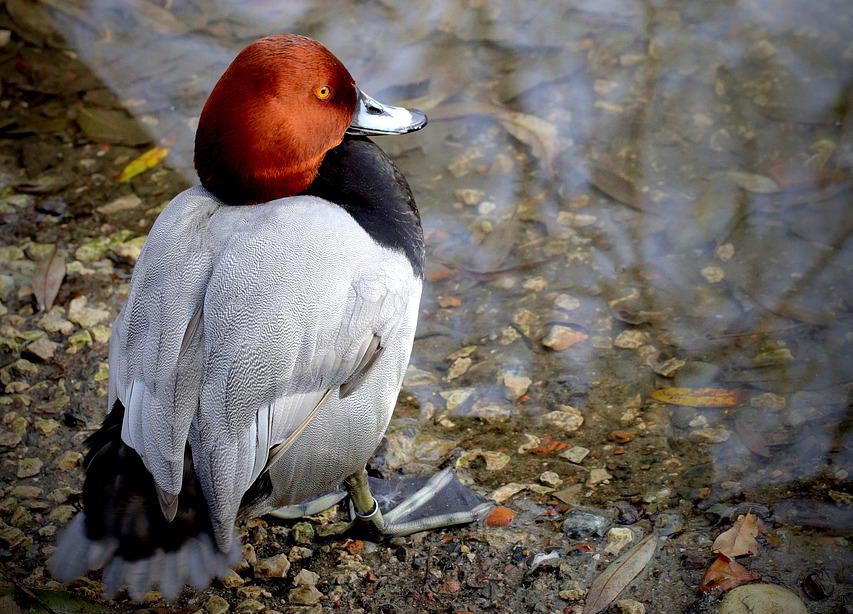
Indiana is home to about 20 different breeds of ducks that come in all shapes, colors, and sizes. They can be found along the coasts of Lake Michigan and in wooded areas and wetlands. Some breeds are braver and more adaptable than others and often live in residential and suburban areas.
We’re bringing both elusive and bold ducks to light. With the proper information, you’ll have a better chance of spotting the different breeds of ducks in Indiana.

The 20 Common Breeds of Ducks in Indiana (With Pictures)
1. American Black Duck
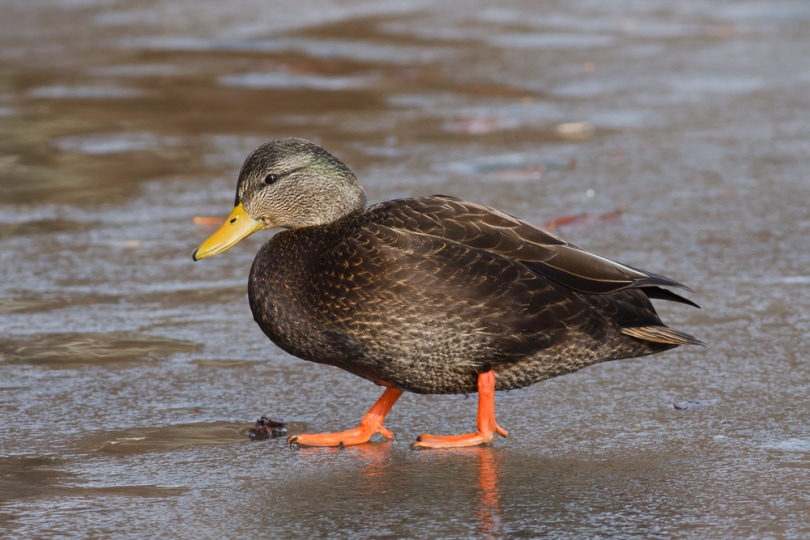
| Scientific Name: | Anas rubripes |
| Rarity: | Mini |
| Type: | Dabbling Duck |
American Black Ducks prefer to live near shallow wetlands, lakes, and ponds. They’re a type of dabbling duck, and their diet consists mainly of insects. You can usually start to see them in the winter.
This duck species can often be found in flocks of Mallards and can easily be spotted against the bright green heads that male Mallards have. They have dark chocolate-colored feathers all over their body and gray feathers on their faces.
2. American Wigeon
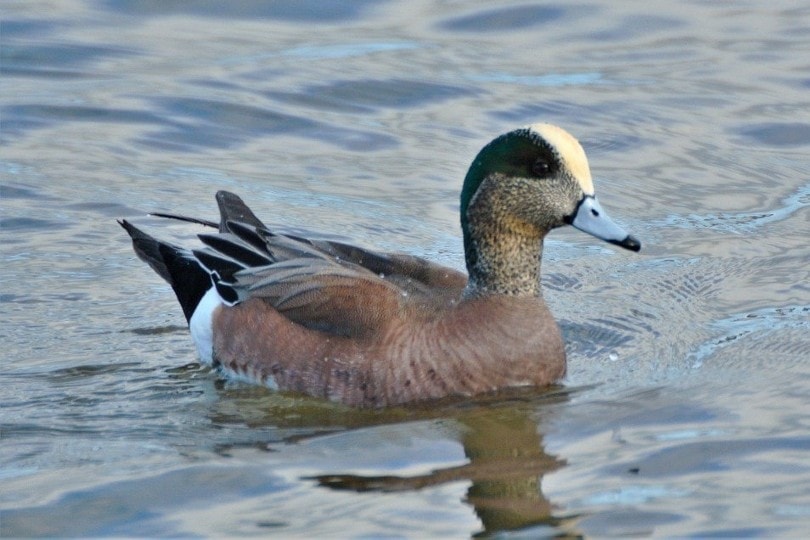
| Scientific Name: | Mareca amiericana |
| Rarity: | Rare |
| Type: | Dabbling Duck |
The American Wigeon is a seasonal duck that you can usually spot in the southern parts of Indiana during migration periods. They’re typically shy birds and populate undisturbed lakes and marshes.
The males have green and white feathers on their heads and a blue-gray bill. They have brown bodies and black tail feathers that stick straight out. The females have brown heads and a mottled brown pattern through the rest of their bodies.
3. Blue-Winged Teal
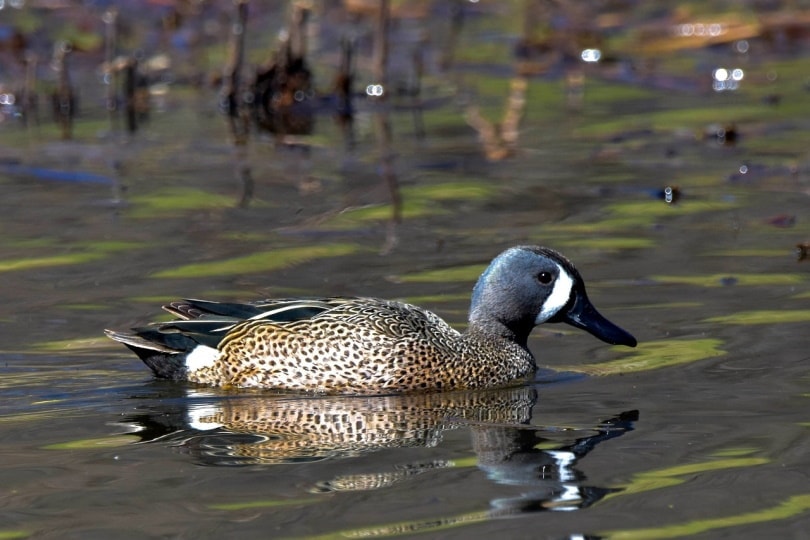
| Scientific Name: | Anas discors |
| Rarity: | Common |
| Type: | Dabbling Duck |
The Blue-Winged Teal has a round head and long bill. The males have dark blue-gray heads, speckled breasts, and black wingtips and tail feathers. The females have brown bills and brown and gray feathers throughout their entire body.
These ducks pass through Indiana as they migrate towards Central America for the winter. They are dabbling ducks that like lakes and deeper ponds where they can forage for insects, aquatic plants, and snails.
4. Bufflehead
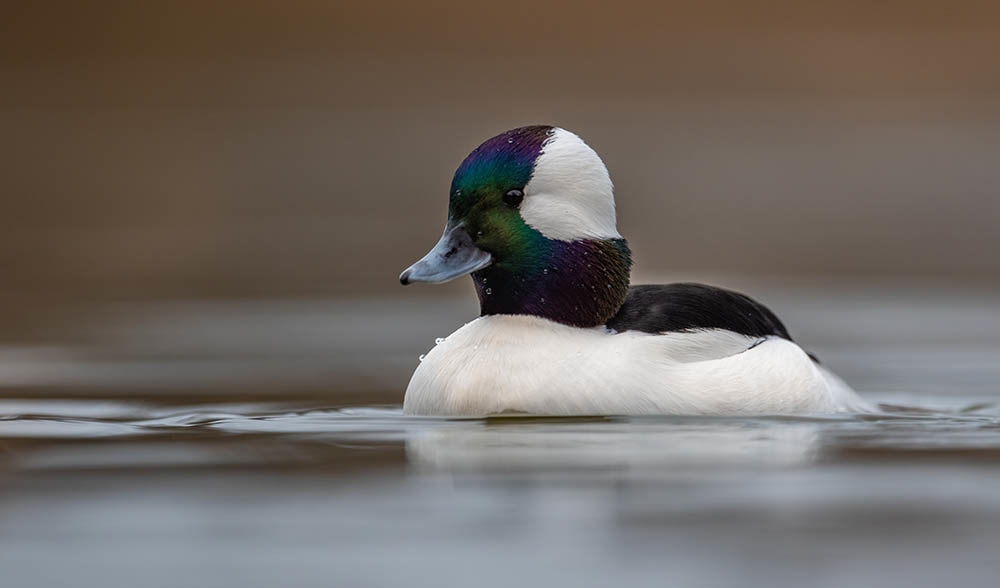
| Scientific Name: | Bucephala albeola |
| Rarity: | Uncommon |
| Type: | Diving Duck |
Buffleheads are beautiful ducks with round heads, and they aren’t too commonly seen in Indiana. You may be able to spot them in the winter. However, it’ll require some patience as these ducks can spend a lot of time hunting and foraging underwater.
Male Buffleheads have bright white feathers on their head with a black crown and green feathers arranged like a mask around their eyes. They have white bellies and black feathers on their back. Females are darker and have feathers that range from black and gray.
5. Canvasback
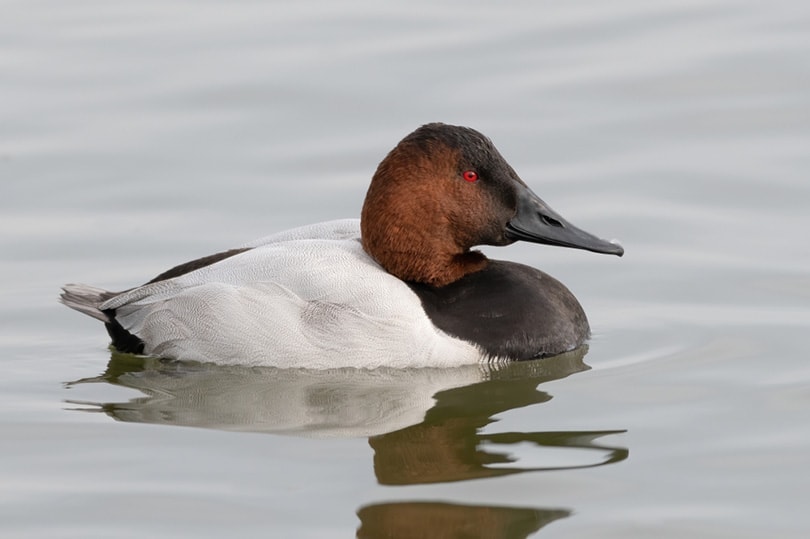
| Scientific Name: | Aythya Valisineria |
| Rarity: | Rare |
| Type: | Diving Duck |
Canvasbacks have narrow, skinny heads and a sloping, flat bill. The males have a chestnut-colored head and a bright white body that contrasts with their black chest. The females are more muted in color and have brown and gray feathers. Male Canvasbacks have red eyes, while females have black eyes.
Canvasbacks are one of the largest species of ducks you can find in Indiana. They usually winter in Indiana and can be found in prairie marshes, boreal forests, and lakes.
6. Common Goldeneye
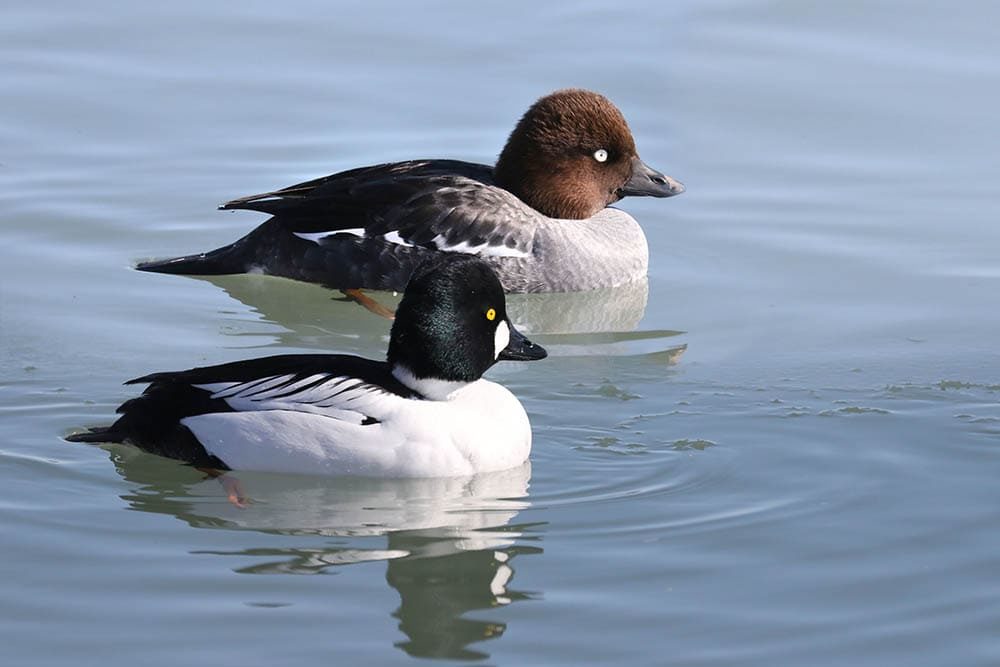
| Scientific Name: | Bucephala |
| Rarity: | Uncommon |
| Type: | Diving Duck |
You have to keep an eye out for Common Goldeneyes, as they’re not very common in Indiana. The males have dark green heads with a tuft of feathers on their crowns. They have yellow eyes and black, sloping bills. The females have a smaller tuft of crown feathers and a slightly shorter bill. Both males and females have patches of white feathers on their wings.
Common Goldeneyes like to live near coastal waters where they can dive and hunt for food. They’re also very fast fliers, so it can be difficult catching a glimpse of them in action.
7. Common Merganser
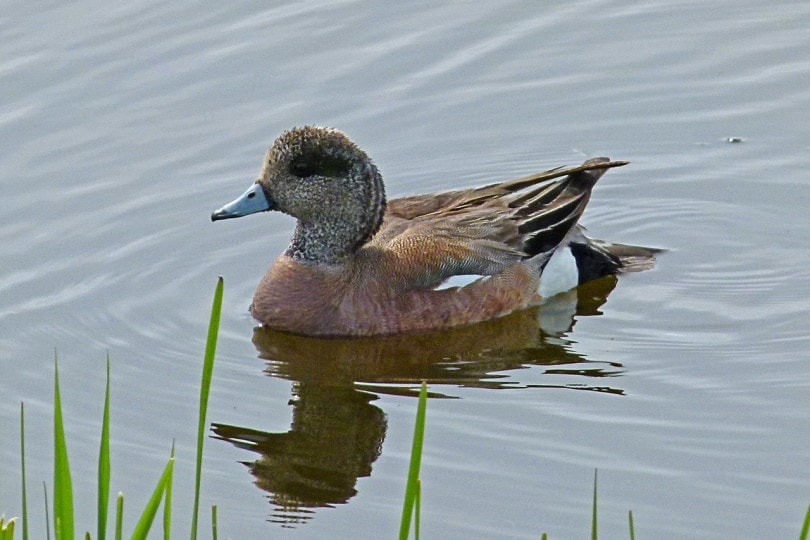
| Scientific Name: | Mergus merganser |
| Rarity: | Common |
| Type: | Diving Duck |
The Common Merganser has a flatter head than most duck species. The males have iridescent green and black heads with a sharp red bill. The females have brown heads and orange bills.
You can usually find these birds along rivers, lakes, and ponds that are ideally running through forests and other areas with a lot of trees. They like to eat fish, and while they’re diving ducks, they tend to only do shallow dives when they hunt.
8. Gadwall
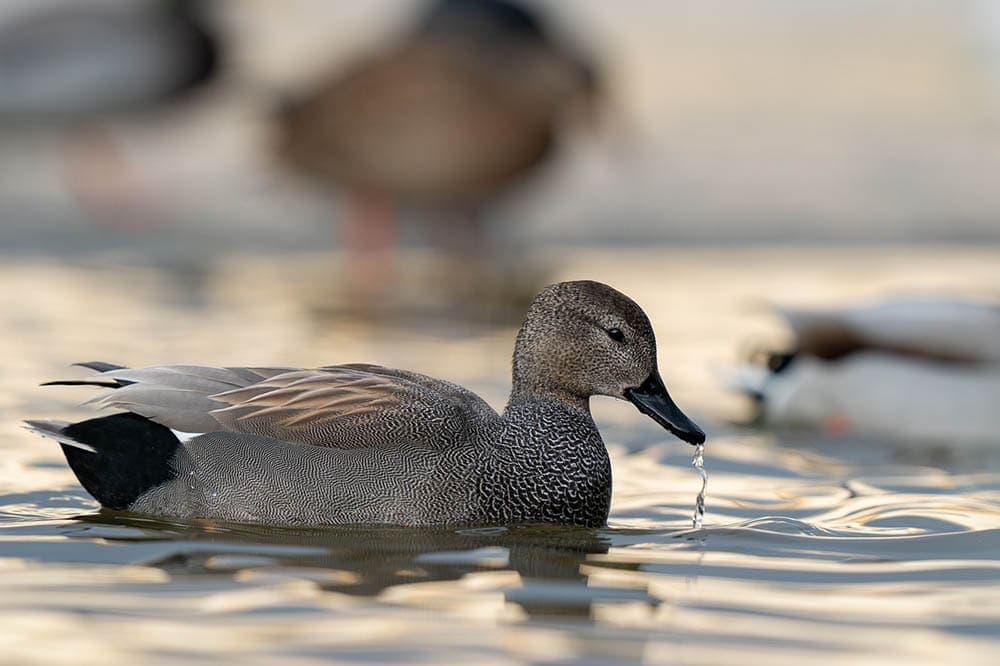
| Scientific Name: | Mareca strepera |
| Rarity: | Rare |
| Type: | Dabbling Duck |
Gadwalls like to live in marshes and wetlands where they can forage for aquatic plants. They’re also known to steal food from diving ducks as they emerge with food in their bills.
Male Gadwalls may look a little plain next to other male duck species. However, upon closer inspection, you’ll notice a beautiful pattern of blue, gray, brown, and black feathers. The females look very similar to female Mallards and have a mottled brown pattern running throughout their bodies.
9. Greater Scaup

| Scientific Name: | Aythya marila |
| Rarity: | Rare |
| Type: | Diving Duck |
Greater Scaups are known to only migrate through Indiana, so they’re more difficult to spot. These ducks prefer living by lakes and ponds. They’re excellent divers and usually forage for aquatic plants and invertebrates that live at the bottom of deep bodies of water.
Male Greater Scaups have dark green heads, yellow eyes, and light blue-gray bills. You can also spot speckled feathers on their backs and solid gray feathers on the rest of their body. Female Greater Scaups have brown heads with a band of white running along their flat bills. Their bodies are also various shades of brown.
10. Green-Winged Teal
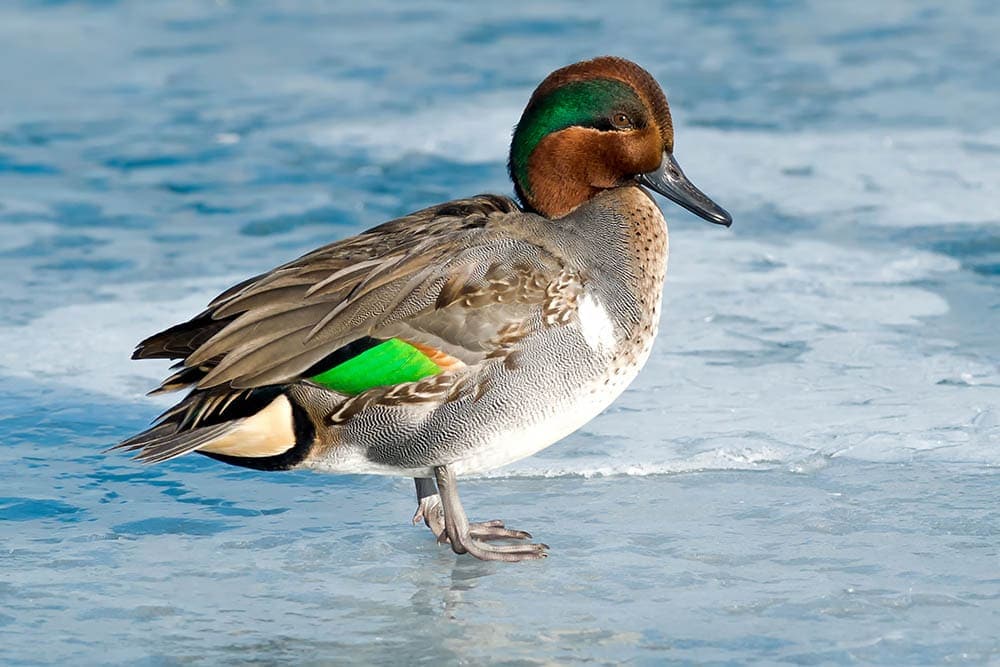
| Scientific Name: | Anas carolinensis |
| Rarity: | Uncommon |
| Type: | Dabbling Duck |
It can be challenging to spot a Green-Winged Teal, and it’s especially satisfying when you find one because of its unique appearance. Males have tan heads with a band of green running along their eyes like a mask. They have beautiful gray and tan feathers on the rest of their bodies. Both males and females have deep green wing feathers that you can see when they’re in flight.
Your best chances of finding Green-Winged Teals are in marshes and wetlands. You can also try to listen for their distinct whistle.
11. Hooded Merganser
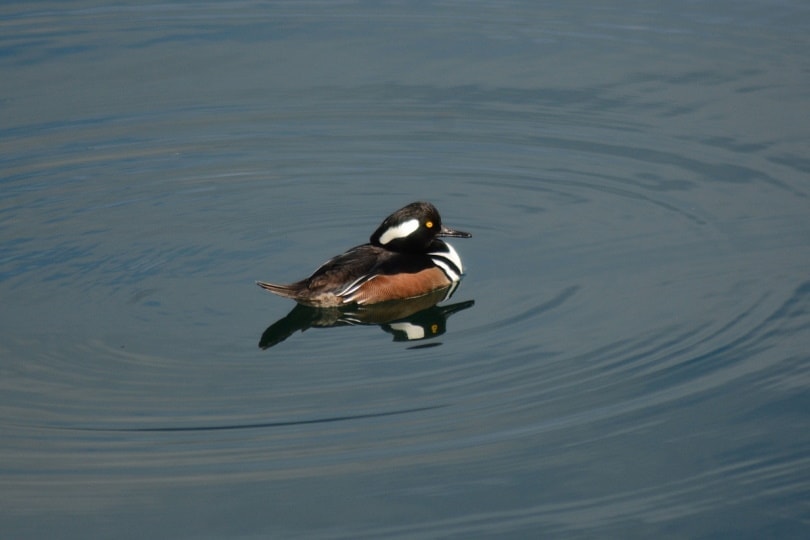
| Scientific Name: | Lophodytes cucullatus |
| Rarity: | Common |
| Type: | Diving Duck |
Both male and female Hooded Mergansers have very distinct appearances. The males are black and white and have an impressive crown of black and white feathers. The females don’t have as large of a crown, but it’s still a sight to see. Their crest is a red-brown color, and they have gray and brown bodies.
Hooded Mergansers are diving ducks that prefer to live near lakes and ponds where they can hunt for fish. They live in Indiana year-round, so if you know what to look for, you can spot them relatively easily.
12. Lesser Scaup

| Scientific Name: | Aythya affinis |
| Rarity: | Common |
| Type: | Diving Duck |
Lesser Scaups are diving ducks that live near large lakes and reservoirs. They only pass through Indiana as temporary residents, so you can only spot them during migration season.
Male Lesser Scaups have yellow eyes that contrast beautifully with their black heads. They have black and white feathers on their bodies and gray speckled feathers on their back. Females look similar to males except they don’t have yellow eyes and they have darker markings.
13. Mallard
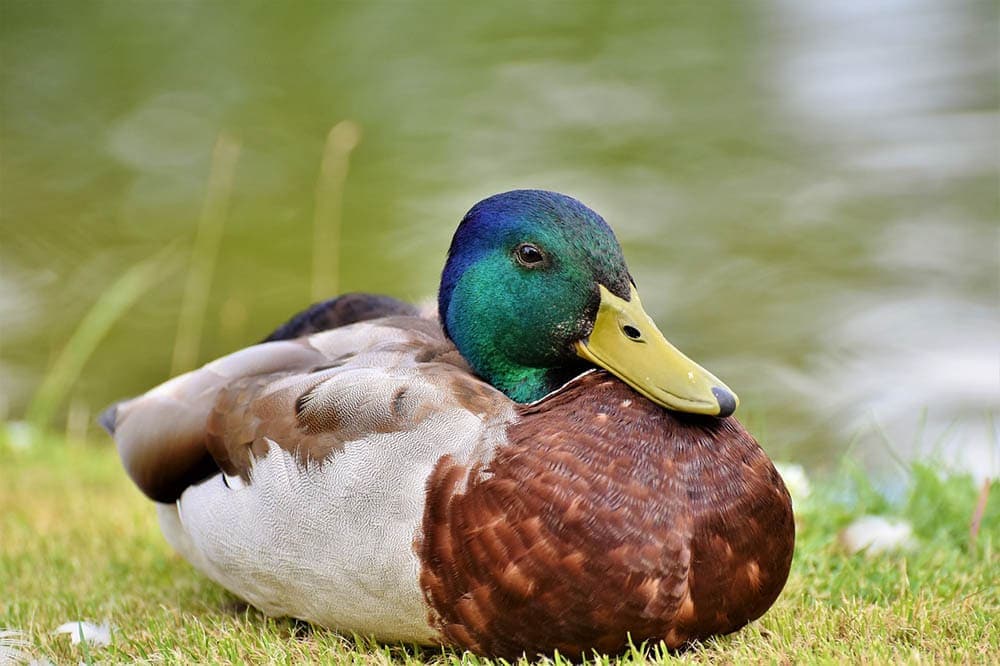
| Scientific Name: | Anas platyrhynchos |
| Rarity: | Common |
| Type: | Dabbling Duck |
The Mallard is one of the most common types of ducks, but it’s still a beautiful sight to see. The male Mallards have iridescent green heads, bright yellow bills, and orange feet. The females have a mottled pattern and have orange bills instead of yellow ones.
Mallards are very adaptable and can be found in residential areas, particularly if they’re next to bodies of water. However, they naturally prefer living in shallow wetlands and lakes.
14. Northern Pintail
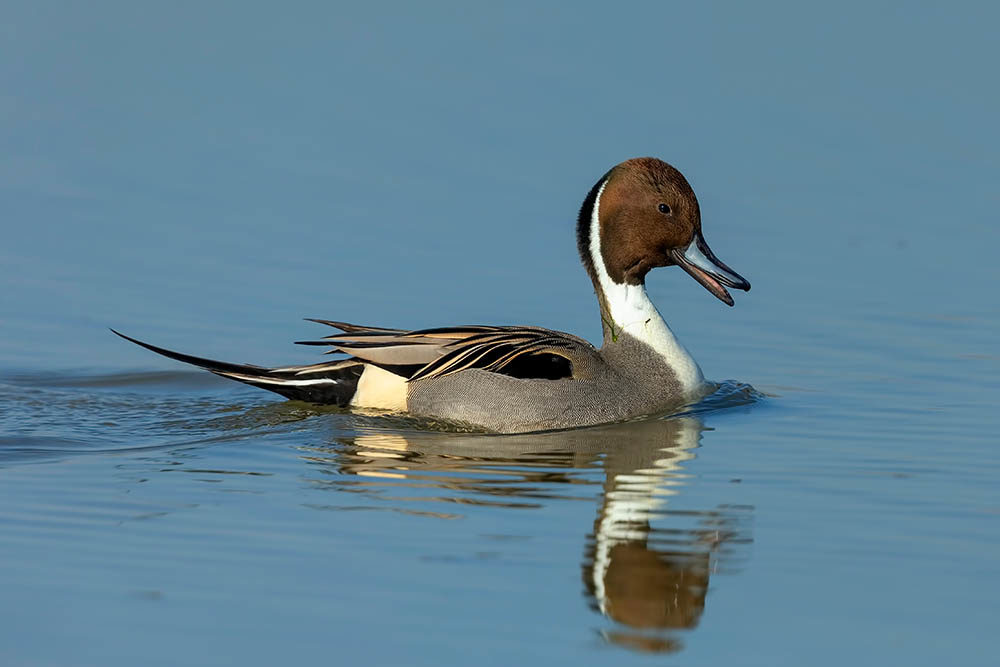
| Scientific Name: | Anas acuta |
| Rarity: | Uncommon |
| Type: | Dabbling Duck |
The Northern Pintail is an elegantly shaped duck with a round head and long neck. The males have chestnut-colored faces and speckled feathers on their backs. They also have gray, green, and white wing feathers and beautiful tail feathers that slightly curl away from their bodies.
The females look similar to female Mallards, and it can be difficult to differentiate the two. Northern Pintails and Mallards also prefer similar natural habitats. So, it’s best to identify the presence of Northern Pintails by looking for the male.
15. Northern Shoveler
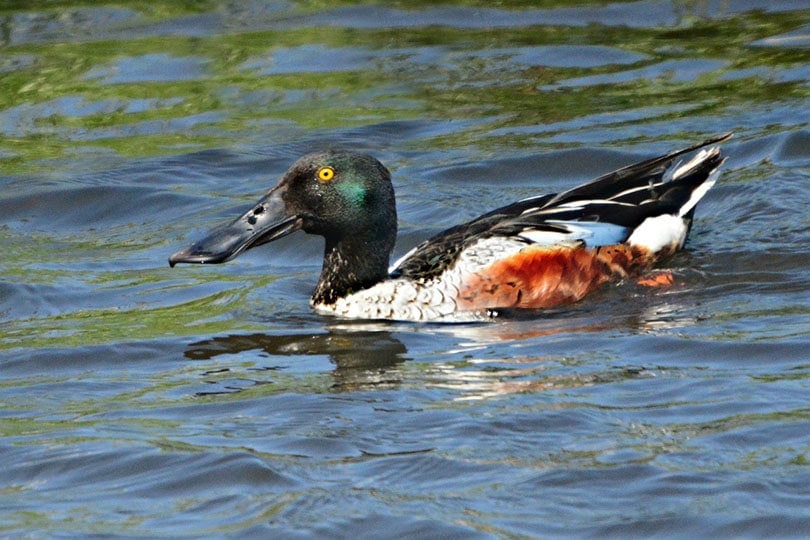
| Scientific Name: | Spatula clypeata |
| Rarity: | Rare |
| Type: | Dabbling Duck |
Northern Shovelers are a rare sight to see because they migrate through just the southern parts of Indiana. So, you might spot them in the wintertime.
Northern Shovelers are known for the large, flat bills. The males tend to have deep green heads and white chests. Their wing feathers are brown, and their tail feathers are black. Female Northern Shovelers have orange bills and mottled brown feathers throughout the entire body.
16. Red-Breasted Merganser

| Scientific Name: | Mergus serrator |
| Rarity: | Rare |
| Type: | Diving Duck |
Red-Breasted Mergansers are easily spotted by the tufts of crest feathers on top of their heads. Females and young males share a similar appearance and have red-orange bills, brown heads, and gray bodies. Mature males have green heads, longer crest feathers, and a chestnut-red chest.
These ducks like to feed on fish, so you’ll have the best luck finding them in areas with larger bodies of water, such as lakes and ponds. They’re relatively rare in Indiana, so it’s quite a treat finding one in its natural habitat.
17. Redhead

| Scientific Name: | Aythya americana |
| Rarity: | Rare |
| Type: | Diving Duck |
The Redhead is named after its cinnamon-colored head. However, only the males have red-colored heads. The females have paler feathers that are brown and mottled. Both males and females have a flat bill that slopes downward.
Redheads are a rare sight to see because they only fly through Indiana on their way to winter in Florida. They’ll fly up again during the breeding season, so you can only spot them during the window of their migration seasons.
18. Ring-Necked Duck

| Scientific Name: | Aythya collaris |
| Rarity: | Uncommon |
| Type: | Diving Duck |
The Ring-Necked Duck is a diving duck that’s not commonly seen throughout Indiana. They can be a little difficult to spot because they don’t have any bold or vibrant colors. Males have black and white feathers, yellow eyes, and white and gray bills with black tips. Females have bills with a similar pattern, but their bodies are mostly gray and brown.
Both males and females have sleek crest feathers on their heads that flatten when they come down for a dive. They like to live in small flocks and dive for mollusks, small aquatic invertebrates, and some aquatic plants.
19. Ruddy Duck

| Scientific Name: | Oxyura jamaicensis |
| Rarity: | Common |
| Type: | Diving Duck |
The Ruddy Duck is best known for the male’s flat blue bill. These birds have a stout build and a thick neck. Males have black and white faces, brown bodies, and black tail feathers that stick straight out. Females have black bills and brown feathers.
Ruddy Ducks are divers and like to eat aquatic invertebrates. They’re active at night, so the best time to sight them would be in the evening.
20. Wood Duck
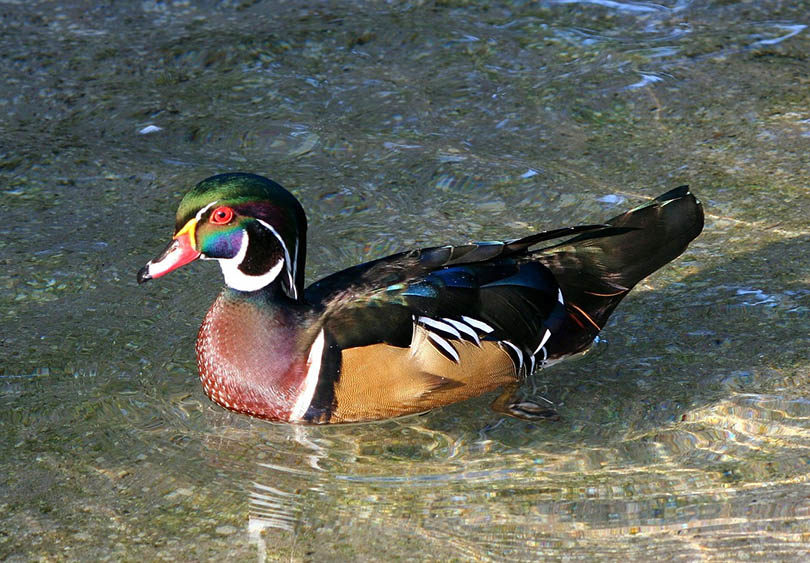
| Scientific Name: | Aix sponsa |
| Rarity: | Common |
| Type: | Dabbling Duck |
The male Wood Duck has one of the most decorated appearances of all the duck breeds in Indiana. Its crested head is green, brown, and black and has white stripes throughout. It also has a speckled chest and intricate markings throughout its chestnut body. Females also have a crested head and a softer, brown, and neutral appearance.
Wood Ducks are competent swimmers, but they also enjoy perching and nesting up in trees. Their ideal habitats are wooded swamps, marshes, and small ponds and lakes.

Final Words
There are so many different kinds of ducks that you can find all throughout Indiana. Many pass through as they’re migrating, so they aren’t permanent residents of the state. The next time you see a duck, make sure to stop and examine its plumage. You may be lucky enough to encounter a guest that’s making a special appearance before continuing on its cross-continental journey.
Featured Image Credit: gianninalin, Pixabay
Table of Contents
- The 20 Common Breeds of Ducks in Indiana (With Pictures)
- 1. American Black Duck
- 2. American Wigeon
- 3. Blue-Winged Teal
- 4. Bufflehead
- 5. Canvasback
- 6. Common Goldeneye
- 7. Common Merganser
- 8. Gadwall
- 9. Greater Scaup
- 10. Green-Winged Teal
- 11. Hooded Merganser
- 12. Lesser Scaup
- 13. Mallard
- 14. Northern Pintail
- 15. Northern Shoveler
- 16. Red-Breasted Merganser
- 17. Redhead
- 18. Ring-Necked Duck
- 19. Ruddy Duck
- 20. Wood Duck
- Final Words
About the Author Jessica Kim
Jessica is a freelance writer who spends most of her day researching and writing a number of topics. She loves sharing helpful information that people can use to better understand their pets, nature and the world around them. When she isn't writing, you may find her walking dogs, tending to her plant babies, or drinking her nth cup of coffee.
Related Articles:
Monocular vs Telescope: Differences Explained (With Pictures)
10 Types of Hummingbirds in Arkansas (With Pictures)
8 Types of Hummingbirds in Nebraska (With Pictures)
5 Types of Hummingbirds in Idaho (With Pictures)
3 Types of Hummingbirds in Mississippi (With Pictures)
8 Types of Hummingbirds in Kansas (With Pictures)
5 Types of Hummingbirds in West Virginia (With Pictures)
5 Types of Hummingbirds in Ohio (With Pictures)
